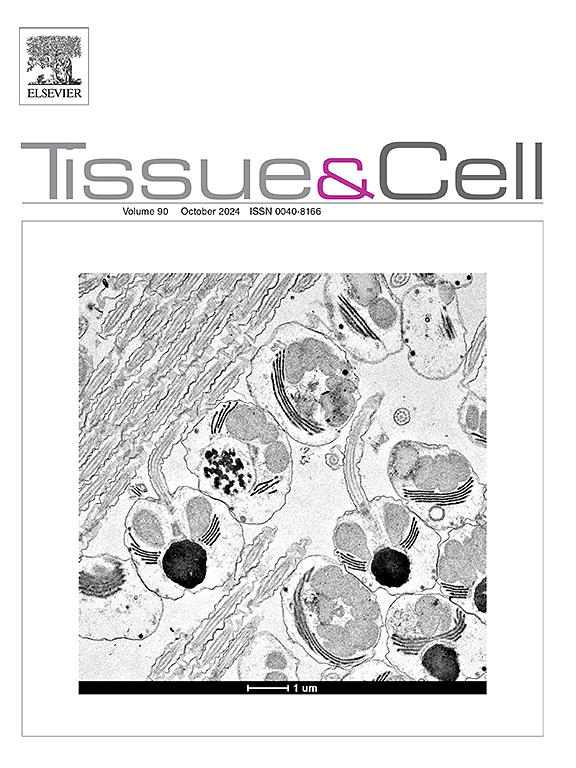Impact of pubertal imidacloprid exposure on the genital tract of Japanese quail (Coturnix Coturnix japonica): Histomorphometric and ultrastructural study
IF 2.7
4区 生物学
Q1 ANATOMY & MORPHOLOGY
引用次数: 0
Abstract
Background
The effects of exposure to the neonicotinoid pesticide, imidacloprid (IMI), on the histopathology and ultrastructure of the genital tracts of pubertal male and female Japanese quails (Coturnix Coturnix japonica) were investigated.
Methods
Pubertal quail (n = 28), commencing at 5 weeks post-hatching, were orally gavaged with 1.55 (low), 3.1 (medium), and 6.2 (high) mg/kg IMI, dissolved in distilled water, twice a week for four weeks. Control birds received distilled water only. Samples collected from male and female genital tracts included epididymal duct and magnum and shell gland. Histopathology, histometric measurements, as well as transmission and scanning electron microscopy were performed.
Results and conclusion
The medium and high IMI doses induced pathomorphological changes in the epithelial cells of the magnum and shell gland, which included a ciliary loss, presence of intracytoplasmic vacuoles, mitochondrial damage, and fewer secretory granules. In addition, there were cytoplasmic vacuoles detected in the efferent ducts and epididymal ducts of quails treated with medium and high IMI doses. The epithelial heights of the magnum, shell gland, rete testis and proximal efferent duct were reduced (P ≤ 0.05) in all IMI treatment groups. In addition, the epididymal duct epithelial heights decreased (P ≤ 0.05) at medium and high IMI doses, but changes in the distal efferent ducts were only observed in the high dose group. Overall, the results confirmed that pubertal exposure to IMI induced dose-dependent pathomorphological changes in male and female quail genital tracts, suggesting that IMI might impact their fertility and reproductive function.
青春期吡虫啉暴露对日本鹌鹑生殖道的影响:组织形态学和超微结构研究
研究了新烟碱类杀虫剂吡虫啉(IMI)对发育期日本鹌鹑(Coturnix Coturnix japonica)雌雄生殖道组织病理学和超微结构的影响。方法从孵化后5周开始,用1.55(低)、3.1(中)、6.2(高)mg/kg IMI灌胃鹌鹑( = 28),每周2次,连续4周。对照鸟只接受蒸馏水。从男性和女性生殖道采集的样本包括附睾管和大、壳腺。进行组织病理学、组织计量学测量以及透射电镜和扫描电镜检查。结果与结论中、高剂量IMI可引起大鼠大网膜和壳腺上皮细胞的病理形态学改变,包括纤毛丢失、胞浆内空泡出现、线粒体损伤和分泌颗粒减少。此外,在中、高剂量IMI处理的鹌鹑的传出管和附睾管中检测到细胞质空泡。IMI治疗组大鼠大网膜、壳腺、睾丸网和近端传来管上皮高度均降低(P ≤ 0.05)。此外,中、高剂量组附睾管上皮高度降低(P ≤ 0.05),远端传出管仅在高剂量组出现变化。综上所述,研究结果证实,青春期暴露于IMI会引起雄性和雌性鹌鹑生殖道的剂量依赖性病理形态学变化,表明IMI可能会影响它们的生育能力和生殖功能。
本文章由计算机程序翻译,如有差异,请以英文原文为准。
求助全文
约1分钟内获得全文
求助全文
来源期刊

Tissue & cell
医学-解剖学与形态学
CiteScore
3.90
自引率
0.00%
发文量
234
期刊介绍:
Tissue and Cell is devoted to original research on the organization of cells, subcellular and extracellular components at all levels, including the grouping and interrelations of cells in tissues and organs. The journal encourages submission of ultrastructural studies that provide novel insights into structure, function and physiology of cells and tissues, in health and disease. Bioengineering and stem cells studies focused on the description of morphological and/or histological data are also welcomed.
Studies investigating the effect of compounds and/or substances on structure of cells and tissues are generally outside the scope of this journal. For consideration, studies should contain a clear rationale on the use of (a) given substance(s), have a compelling morphological and structural focus and present novel incremental findings from previous literature.
 求助内容:
求助内容: 应助结果提醒方式:
应助结果提醒方式:


